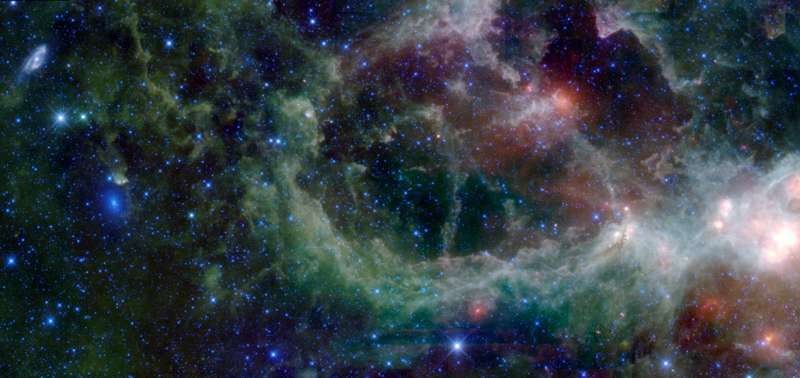Explanation: The two galaxies on the far left were unknown until 1968. Although they would have appeared as two of the brighter galaxies on the night sky, the opaque dust of the central band of our Milky Way Galaxy had obscured them from being seen in visible light. The above image in infrared light taken by the recently launched Wide-Field Infrared Survey Explorer (WISE), however, finds these galaxies in great detail far behind -- but seemingly next to -- the photogenic Heart nebula (IC 1805). The spiral galaxy near the top is the easiest to spot and is known as Maffei 2. Just below and to its right is fuzzy-looking Maffei 1, the closest giant elliptical galaxy to Earth. The above false-colored image spans three full moons from top to bottom. The Maffei galaxies each span about 15,000 light years across and lie about 10 million light years away toward the constellation of the Queen of Ethiopia (Cassiopeia). On the image right, stars, gaseous filaments, and warm dust highlight a detailed infrared view of the Heart nebula.
1999 2000 2001 2002 2003 2004 2005 2006 2007 2008 2009 2010 2011 2012 2013 2014 2015 2016 2017 2018 2019 2020 2021 2022 2023 2024 2025 |
Yanvar' Fevral' Mart Aprel' Mai Iyun' Iyul' Avgust Sentyabr' Oktyabr' Noyabr' Dekabr' |
NASA Web Site Statements, Warnings, and Disclaimers
NASA Official: Jay Norris. Specific rights apply.
A service of: LHEA at NASA / GSFC
& Michigan Tech. U.
|
Publikacii s klyuchevymi slovami:
Heart Nebula - ellipticheskaya galaktika - spiral'naya galaktika - tumannost'
Publikacii so slovami: Heart Nebula - ellipticheskaya galaktika - spiral'naya galaktika - tumannost' | |
Sm. takzhe:
Vse publikacii na tu zhe temu >> | |
